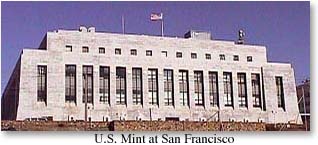|
New Mint Strong as a Fortress
Will Defy Fire, Earthquakes and Attempts at Robbery
The new San Francisco Mint, scheduled to be completed next February, will
be structurally stronger and better protected than many a fortress. It will resist
fire and earthquakes and withstand any attempts at robbery.
 Every
detail of the building’s design and construction guarantees strength and durability.
Its foundations go deep into a hill of solid rock. It has an exceptionally sturdy
steel framework and heavy exterior walls of reinforced concrete and granite, with
everything else on the same scale. Besides being fireproof, it embodies several
special engineering features to make it earthquake-resistive. Every
detail of the building’s design and construction guarantees strength and durability.
Its foundations go deep into a hill of solid rock. It has an exceptionally sturdy
steel framework and heavy exterior walls of reinforced concrete and granite, with
everything else on the same scale. Besides being fireproof, it embodies several
special engineering features to make it earthquake-resistive.
Safeguards against holdups will be numerous and effective. Heading the
list will be a network of pipes by which the place can be flooded with tear gas
almost instantly. A gun tower will cover all approaches. Defense lights, set in
the walls, will illuminate the exterior at night. Both front and rear entrances
will have two electrically-operated steel doors, so controlled that only one of
each set can be opened at a time. A self-starting power generator will automatically
begin running the moment anyone tampers with the regular service and thus foil efforts
to darken the building and cripple its protective devices. There will be two alarm
systems, a watchmen's report system and a radio communication system.
To keep Uncle Sam’s gold and silver safe, the storage vault and the
melting and refining vault will have reinforced concrete walls two feet thick. The
storage vault will be 72 feet long by 44 feet wide and the refining vault 48 feet
by 33 feet. Several smaller vaults will be almost as formidable.
The new Mint, costing more than $1,000,000 occupies the block bounded
by Duboce, Buchanan, Hermann and Webster streets, and fronts on Duboce. The site
has steep cliffs on three sides and is 100 feet above the pavement at the corner
where Duboce and Buchanan intersect Market street. A concrete stairway of 72 steps
leads to the main entrance.
The structure is 208 feet long by 185 feet wide and three stories high
over the whole area, with two additional stories in front. It was designed by Gilbert
Stanley Underwood, Treasury Department architect. The Clinton Construction Company
is the general contractor and Scott Fullerton is construction engineer, representing
the Treasury Department. Jacob J. Creskoff, an engineer of Philadelphia, planned
the earthquake-resistive features. All plans were prepared with the cooperation
of Peter J. Haggerty, Superintendent of the Mint.
On the first floor will be a marble lobby, the large storage and melting
vaults, vaults for nickel and copper, a plumbing shop, blacksmith shop, carpenter
shop, boiler room, emergency generator room and locker rooms.
Offices will fill the front of the second floor and behind them will be
several rooms for minting operations. The third floor will contain more minting
rooms, more offices, an assay laboratory and a women’s lunch room.
On the fourth floor will be an elaborate precipitation system which will
recover all metallic particles from the vapors emitted by the metal furnaces. The
equipment consists of a series of tubes, in which the air is electrified with 75,000-volt
electricity. As the vapors pass through these tubes the high-frequency current
ionizes the metal content and the the particles cling to the sides of the tubes,
where they are recovered. Also on this floor will be an electric shop, record room
and a men’s lunch room.
A pistol range will be installed on the fifth floor and the rest of the
space will be taken up by record storage rooms and machinery to run the elevators.
P.G. and E. service will play an important part in this money-making
plant. Electricity will operate the machinery and most of the protective devices.
Likewise, gas will be used for many purposes.
Opening of the new building will mark the eighty-third year of the San
Francisco Mint. The first Mint was established in 1854, in Commercial street, between
Montgomery and Kearny, and for many years turned out a steady stream of gold and
silver coins. The present Mint, at Mission and Fifth streets, was begun in 1870
and put into operation in 1874. Last year it handled 2,493,334 ounces of gold and
28,230,585 ounces of silver– and its successor will be capable of handling
infinitely more.
P.G and E. Progress
October 1936
Return to the top of the page.
This site and contents ©1995-2013 The Museum of the City
of San Francisco
|